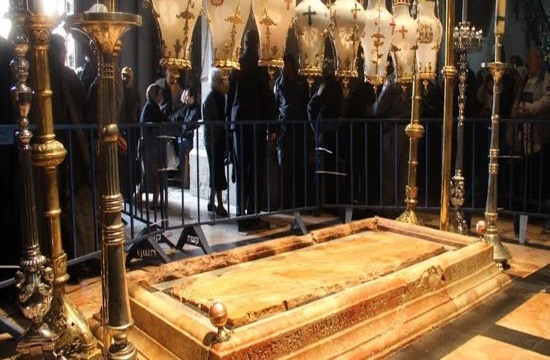Ongoing work to restore the aedifice surrounding Jesus’ tomb in the Church of the Holy Sepulcher in Jerusalem is now in its most crucial phase, the head of the National Technical University of Athens (NTUA) Restoration Team Antonia Moropoulou said Athens-Macedonian News Agency (ANA) on Sunday.
The project was recently in the spotlight after news that scientists had revealed Jesus’ burial site for the first time in centuries, removing the marble cladding that had covered it since at least 1555 AD, if not earlier.
According to Moropoulou, the team was now in the “heart” of developing the project in what she described as a “life-changing experience”.
“On October 26, we rolled the slab of the Holy Sepulcher as we were finishing the injection phase and had to protect the Holy Rock. Under the marble slab of Calfas Komninos, the famous architect who carried out the restoration of the tomb in 1810 (after the fire of 1808), we found another slab which probably came from the Crusades – evidenced by the characteristic Crusader cross that ‘she wore. . Below we found the stone shelf on which Jesus’ body is believed to have been placed.
“We have opened a window so that the Sacred Rock is still visible to visitors. We are now in the final stages of the project, which involves replacing the decorative marble and stone plaques that we removed in order to restore them in a manner stable the Edicule, in a way that guarantees the integrity of the monument and the durability of the solution that we propose, given that the cause of the deformation of the Edicule remains: it is no longer rainwater which had been falling for years from the dome of the Church of the Holy Sepulcher – the dome is now sealed – but the waters rising from the basement, from a complex which connects the entire church to underground canals“, said Moropoulou. She noted that excavations and some sort of intervention will be necessary in the near future.
She also spoke of the unique and deeply moving nature experience that the project provided for the Greek team, as well as the serious responsibility it carried.
“Next to the Holy Sepulchre, as part of the project, we have installed an interdisciplinary laboratory. We want the discoveries we announce to be owned by the whole world. What touches us all is that the Tomb of Christ is a living tomb. It sends a message of resurrection and hope and this is what touched us and allowed us to work” she told ANA.
The work of the interdisciplinary team Work on the tomb began in June this year, following an invitation from Jerusalem Patriarch Theophilus to the NTUA. The patriarch first obtained the agreement of the two other religious communities which participate in the management of the site, the Franciscan order and the Armenian Patriarchate of Jerusalem. The team is led by Moropoulou, a chemist, and includes architecture professor Manolis Korres, civil engineering professor Constantinos Spyrakos and land surveyor Andreas Georgopoulos. The team presented its plans in January 2016 in Jerusalem, in the presence of the Prime Minister, then in February to the leaders of the three religious communities responsible for the church, as well as at an audience in Athens in March. The restoration work is expected to be completed in March 2017.
Learn more here.
RELATED TOPICS: Greece, Greek tourism news, Tourism in Greece, The Greek Islands, Hotels in Greece, Travel to Greece, Greek destinations , Greek travel market, Greek tourism statistics, Greek Tourism Report


